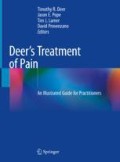Abstract
Radiofrequency ablation is a well-established therapy to treat axial spine, facet-mediated pain. The targets are the medical branches which can be found at all levels of the spine. The thoracic spine, though not as a common source of pain, responds as well to medial branch therapies including radiofrequency ablation. Given the variable anatomy of the medial branches from T1 to T12, it is important to understand the location and technique of this procedure to maximize its efficacy. Herein we describe the background, indications, techniques, as well as pearls and pitfalls that will allow practitioners to provide safe and effective treatment for those suffering from mid back pain.
Access this chapter
Tax calculation will be finalised at checkout
Purchases are for personal use only
Recommended Reading
Atluri S, et al. Systematic review of diagnostic utility and therapeutic effectiveness of thoracic facet joint interventions. Pain Physician. 2008;11(5):611–29.
Boswell MV, et al. A systematic review of therapeutic facet joint interventions in chronic spinal pain. Pain Physician. 2007;10(1):229–53.
Chua WH, Bogduk N. The surgical anatomy of thoracic facet denervation. Acta Neurochir [Wien]. 1995;136:140–4.
Dreyfuss P, Tibiletti C, Dreyer SJ. Thoracic zygapophyseal joint pain patterns. A study in normal volunteers. Spine (Phila Pa 1976). 1994;19(7):807–11.
Fukui S, Ohseto K, Shiotani M. Patterns of pain induced by distending the thoracic zygapophyseal joints. Reg Anesth. 1997;22(4):332–6.
Manchikanti L, et al. Comparative effectiveness of a one-year follow-up of thoracic medial branch blocks in management of chronic thoracic pain: a randomized, double-blind active controlled trial. Pain Physician. 2010;13(6):535–48.
Manchikanti KN, et al. An update of evaluation of therapeutic thoracic facet joint interventions. Pain Physician. 2012;15(4):E463–81.
Manchikanti L, et al. Assessment of the escalating growth of facet joint interventions in the medicare population in the United States from 2000 to 2011. Pain Physician. 2013;16(4):E365–78.
Manchikanti L, et al. A systematic review and best evidence synthesis of the effectiveness of therapeutic facet joint interventions in managing chronic spinal pain. Pain Physician. 2015;18(4):E535–82.
Provenzano DA, Lassila HC, Somers D. The effect of fluid injection on lesion size during radiofrequency treatment. Reg Anesth Pain Med. 2010;35(4):338–42.
Provenzano DA, Liebert MA, Somers DL. Increasing the NaCl concentration of the preinjected solution enhances monopolar radiofrequency lesion size. Reg Anesth Pain Med. 2013;38(2):112–23.
Speldewinde G. Outcomes of percutaneous zygapophysial and sacroiliac joint neurotomy in a community setting. Pain Med. 2011;12(2):209–18.
Stolker RJ, Vervest AC, Groen GJ. Percutaneous facet denervation in chronic thoracic spinal pain. Acta Neurochir. 1993;122(1–2):82–90.
Tzaan WC, Tasker RR. Percutaneous radiofrequency facet rhizotomy–experience with 118 procedures and reappraisal of its value. Can J Neurol Sci. 2000;27(2):125–30.
Walega D, et al. Third-degree burn from cooled radiofrequency ablation of medial branch nerves for treatment of thoracic facet syndrome. Pain Pract. 2014;14(6):e154–8. https://doi.org/10.1111/papr.12222. Epub 2014 May 2.
Author information
Authors and Affiliations
Editor information
Editors and Affiliations
Rights and permissions
Copyright information
© 2019 Springer Nature Switzerland AG
About this chapter
Cite this chapter
Lee, E.T., Price, C. (2019). Radiofrequency Ablation in the Thoracic Spine. In: Deer, T., Pope, J., Lamer, T., Provenzano, D. (eds) Deer's Treatment of Pain. Springer, Cham. https://doi.org/10.1007/978-3-030-12281-2_48
Download citation
DOI: https://doi.org/10.1007/978-3-030-12281-2_48
Published:
Publisher Name: Springer, Cham
Print ISBN: 978-3-030-12280-5
Online ISBN: 978-3-030-12281-2
eBook Packages: MedicineMedicine (R0)

